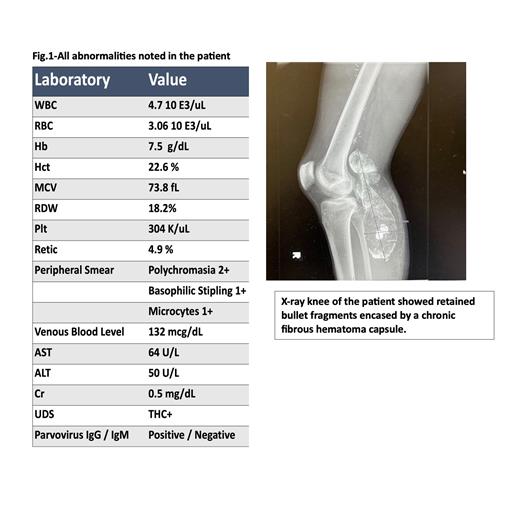Introduction
The full extent of adult lead poisoning and toxicity is difficult to ascertain because of limited data; existing data and research findings suggest that it remains an important environmental and public health problem even if population levels are decreasing. The prevalence of elevated lead levels is decreasing in the United States. The consequences of lead exposure may be reduced by taking an occupational and environmental health history, recognizing the early symptoms of elevated blood lead levels (BLLs) and lead poisoning, having a low threshold for suspecting asymptomatic lead exposure based on an occupational and environmental history or medical findings, and checking BLL in such cases to verify the diagnosis and provide appropriate advice and treatment.
Case Presentation
A 19-year-old Hispanic male presented to the emergency department with symptoms of worsening abdominal pain, anorexia, weight loss (10 lbs. over 2 months), constipation, low back pain, right knee pain, and headache that has been going on for two weeks. Complete blood counts showed microcytic anemia with a peripheral smear showing basophilic stippling; Computerized tomography of the head, abdomen, and pelvis showed no acute findings. Iron profile was within normal limits. Upon careful history and examination, he revealed that he had suffered an accidental gunshot injury to his right knee 6 years ago with retained bullet and had undergone a popliteal artery repair. His knee ray showed retained bullet fragment encased in a chronic calcified hematoma. This led us to suspect lead poisoning and ordering of venous lead level. His blood lead level came back and was elevated to a toxic level of 136.2 mcg/dl (Normal <5.0 mcg/dl).
The patient was taken to the operation theatre for extraction of bullet fragments, and the hematoma that was evacuated showed that the inside of the capsule had blackish-grey discoloration possibly from lead. Simultaneously the patient was started on the chelating agent, Succimer. The patient's symptoms gradually improved and were at baseline with no active complaints. He was followed as an outpatient and lead levels were noted to be down trending. He continues to be followed with monthly checks of his blood lead levels.
Discussion
In lead poisoning, symptoms are most likely to occur in adults with blood lead levels (BLL) >80 mcg/dL. With BLL 40 to 80 mcg/dL, the symptoms are less severe and are variable. Adults with BLL <40 mcg/dL are usually asymptomatic and lead toxicity should be a diagnosis of exclusion. While acute intoxication leads to gastrointestinal, musculoskeletal, neuropsychiatric, and hematological effects, chronic exposure is linked to increased risks of mortality from oncological and cardiovascular causes. Because lead poisoning often presents with nonspecific symptoms and signs, the diagnosis must be suspected based on exposure, occupational history, and other associated symptoms. BLL should be obtained as this forms the basis upon which management and decisions are made. Chelation therapy is suggested for patients with a BLL >80 mcg/dL and all patients with a BLL > 100 mcg/dL. At a minimum, for patients with BLL <10 mcg/dL, surveillance with repeat BLL testing should be done at least annually if lead exposure continues. For BLL 10 to 29 mcg/dL, a repeat BLL should be obtained every three months until BLL is reduced to <10 mcg/dL. For BLL >30 mcg/dL, BLL should be repeated every month.
Disclosures
No relevant conflicts of interest to declare.


This feature is available to Subscribers Only
Sign In or Create an Account Close Modal